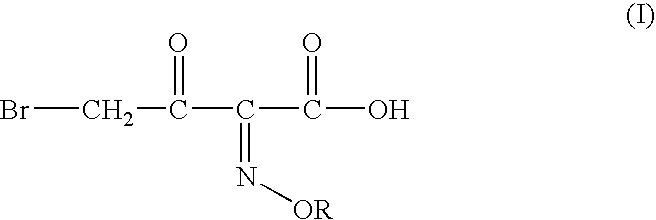Process for manufacture of a 4-bromo-2-oxyimino butyric acid and its derivatives
a technology of oxyiminobutyric acid and oxyiminobutyric acid, which is applied in the field of large-scale synthesis of 4bromo2oxyiminobutyric acid, can solve the problems of limited application and restriction, unstable dibromo derivatives (v) cannot be stored, and commercially unavailable, and achieves high yield and purity.
- Summary
- Abstract
- Description
- Claims
- Application Information
AI Technical Summary
Benefits of technology
Problems solved by technology
Method used
Image
Examples
example-1
Preparation of 4-bromo-2-methoxyimino-3-oxo Butanoic Acid:
tert-butyl 2-methoxyimino-3-oxo butyrate (120 gm, 0.597moles), acetyl bromide (72.50 gm; 0.5894 moles; 0.987 molar eq.) and methanol (55 gm; 1.77 moles; 2.97 molar eq.) were mixed in ethyl acetate (300 ml) at 5-10° C. To the solution thus obtained cooled to −6 to −10° C. was added dropwise a solution of bromine (96 gm; 0.600 moles; 1 molar eq.) in ethyl acetate (60 ml). The mixture was agitated at the same temperature till completion of reaction, after which it was washed with an aqueous solution of sodium dithionate, followed by saturated brine solution. The organic layer is separated and basified to adjust the pH between 6.50 to 7.00. The aqueous phase is separated and mixed with dichloromethane. The pH of the mixture is adjusted to 0.40 by addition of Conc. HCl. The organic layer is separated, washed with saturated brine solution and evaporated off under reduced pressure to give crude 110 gm (80.91%) of the title compound(...
example-2
Preparation of 4-bromo-2-methoxyimino-3-oxo Butanoic Acid:
tert-butyl 2-methoxyimino-3-oxo butyrate (100 gm; 0.497 moles), acetyl bromide (60 gm; 0.488 moles; 0.98 molar eq.) and methanol (58 gm; 1.81 moles; 3.64 molar eq.) were mixed in dichloromethane (200 ml) at −5 to −10° C. To the solution thus obtained cooled to −12 to −10° C. was added dropwise a solution of bromine (78 gm, 0.488 moles; 0.98 molar eq.) in dichloromethane (100 ml). The mixture was agitated at the same temperature till completion of reaction, after which it was washed with an aqueous solution of sodium dithionate, followed by saturated brine solution. The organic layer is separated and basified to adjust the pH between 6.50 to 7.00. The aqueous phase is separated and mixed with dichloromethane. The pH of the mixture is adjusted to 0.40 by addition of Conc. HCl. The organic layer is separated, washed with saturated brine solution and evaporated off under reduced pressure to give crude 97 gm (85.720%) of the title...
example-3
Preparation of 4-bromo-2-methoxyimino-3-oxo Butanoic Acid:
tert-butyl 2-methoxyimino-3-oxo butyrate (50 gm, 0.248moles), acetyl bromide (31 gm; 0.25 moles; 1.0 molar eq.) and ethanol (23 gm; 0.5 moles; 2.0 molar eq.) were mixed in ethyl acetate (200 ml) at 5-10° C. To the solution thus obtained cooled to −6 to −10° C. was added dropwise a solution of bromine (39.68 gm; 0.248moles; 1 molar eq.) in ethyl acetate (50 ml). The mixture was agitated at the same temperature till completion of reaction, after which it was washed with an aqueous solution of sodium dithionate, followed by saturated brine solution. The organic layer is separated and basified to adjust the pH between 6.50 to 7.00. The aqueous phase is separated and mixed with dichloromethane. The pH of the mixture is adjusted to 0.40 by addition of Conc. HCl. The organic layer is separated, washed with saturated brine solution and evaporated off under reduced pressure to give crude 43 gm of the title compound(Z:E=90:10) as visco...
PUM
| Property | Measurement | Unit |
|---|---|---|
| temperature | aaaaa | aaaaa |
| temperature | aaaaa | aaaaa |
| temperature | aaaaa | aaaaa |
Abstract
Description
Claims
Application Information
 Login to View More
Login to View More - R&D
- Intellectual Property
- Life Sciences
- Materials
- Tech Scout
- Unparalleled Data Quality
- Higher Quality Content
- 60% Fewer Hallucinations
Browse by: Latest US Patents, China's latest patents, Technical Efficacy Thesaurus, Application Domain, Technology Topic, Popular Technical Reports.
© 2025 PatSnap. All rights reserved.Legal|Privacy policy|Modern Slavery Act Transparency Statement|Sitemap|About US| Contact US: help@patsnap.com



